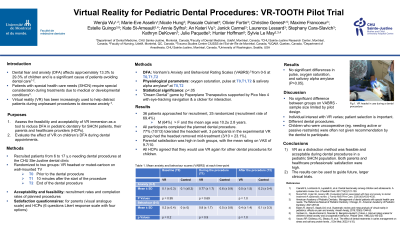Special Health Care Needs
101 - Virtual Reality for Pediatric Dental Procedures: VR-TOOTH Pilot Trial


Wenjia Wu, DMD (she/her/hers)
Resident in pediatric dentistry
University of Montreal
University of Montreal
Brossard, Quebec, Canada- SL
Sylvie Le May, RN, PhD
Research Center, Centre Hospitalier Universitaire Sainte-Justine
- NH
Nicole Hung, BScN, MD
Faculty of Medicine, University of Montreal
- OF
Olivier Fortin, BDI, MSc
Research Center, Centre Hospitalier Universitaire Sainte-Justine
- CG
Christine Genest, RN, PhD
Faculty of Nursing, University of Montreal
- MF
Maxime Francoeur, BSN
Research Center, Centre Hospitalier Universitaire Sainte-Justine
- EG
Estelle Guingo, PhD
Research Center, Centre Hospitalier Universitaire Sainte-Justine
- KS
Kate St-Arneault, MScN
Research Center, Centre Hospitalier Universitaire Sainte-Justine
- AV
An Kateri Vu, -
Research Center, Centre Hospitalier Universitaire Sainte-Justine
- AS
Annie Sylfra, -
Research Center, Centre Hospitalier Universitaire Sainte-Justine
- JC
Janick Carmel, -
Research Center, Centre Hospitalier Universitaire Sainte-Justine
- LL
Laurence Lessard, -
Research Center, Centre Hospitalier Universitaire Sainte-Justine
- SC
Stephany Cara-Slavich, BAA
Research Center, Centre Hospitalier Universitaire Sainte-Justine
- KK
Katheryn De Koven Katheryn De Koven, MD
Centre Hospitalier Universitaire St-Justine Hospital
- JP
Julie Paquette, RN, MSc
Research Center, Centre Hospitalier Universitaire Sainte-Justine
- HH
Hunter Hoffman, PhD
University of Washington
- MA
Marie-Ève Asselin, DMD, MSc, F.R.C.D(c)
Centre Hospitalier Universitaire Sainte-Justine
- SL
Sylvie Le May, RN, PhD
Researcher
Research Center, Centre Hospitalier Universitaire Sainte-Justine, Montreal, QC
Montreal, Quebec, Canada - BD
Basma Dabbagh, DMD, MSc, FRCDC, ABPD
Assistant professor, Co-Director, Pediatric Dentistry Program
Université de Montréal, Montreal, QC
Montreal, Quebec, Canada
Presenting Author(s)
Co-Author(s)
Research Mentor(s)
Program Director(s)
Introduction: Dental fear and anxiety (DFA) is a condition that affects approximately a quarter of children and adolescents. It is a significant cause for pediatric patients to avoid dental care later in adulthood. Lack of patient cooperation due to DFA can create an environment of stress, often obligating dentists to end appointments prematurely and consider alternative pharmacological treatment options. Virtual reality (VR) headset use during dental care, providing an immersive experience through sensory stimuli, is a potential non-pharmacologic adjunct to better manage DFA in children with special health care needs (SHCN) undergoing dental procedures.
Purposes: 1) Assess the feasibility and acceptability of VR immersion as a tool to reduce dental fear and anxiety in pediatric SHCN patients undergoing dental procedures, as well as their parents and healthcare providers (HCPs).
2) Evaluate the effect of VR on children’s DFA during dental appointments.
Methods: This pilot randomized controlled trial conducted at CHU-Ste Justine Hospital in Montreal followed a parallel design where participants were randomized in two groups: control (cartoons on wall-mounted TV) and experimental (VR game). Primary outcomes were patient recruitment rates and completion rate of procedures. DFA was assessed using the Venham Anxiety and Behavior Rating Scales (VABRS) and alpha-amylase (stress biomarker). Descriptive and non-parametric mean comparisons tests were used for analyses of demographic, clinical variables, satisfaction and VABRS.
Results: Out of 36 patients approached for recruitment, 25 (69.4%) accepted to participate (13 randomized to the VR group and 12 in the control group). Mean age of participants was 10.2 (± 2.8 ) years and 64% were males. Overall, 77% (10/13) of participants in the VR group tolerated the headset during the procedure. Parental and HCPs satisfaction were high: 100% of HCPs indicated they would use VR again; all parents rated the VR intervention with a score of 8/10 or higher. There was no significant difference between groups on VABRS and physiological biomarkers (P >.05).
Conclusion: This pilot study showed that VR was a feasible and acceptable tool for SHCN children to reduce fear and anxiety during dental treatments. Parents and HCPs were highly satisfied.
Identify Supporting Agency and Grant Number: Research supported by funds from the Implementation of Virtual Reality Fund of the CHU Sainte-Justine, Quebec, Canada.

.jpg)